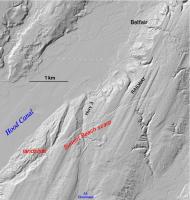
A trench log
USGS
website on studies of the Seattle fault

Photo of a trench wall (116 kB), view
to west

scarp (n). A linear cliff or step in slope, need not be high. Can be formed by differential erosion of adjacent hard and soft rock; by localized erosion, for example at the edge of a river terrace; by movement of a landslide; or by a shallow earthquake that is large enough to break the Earth's surface.Trenches across fault scarps can expose buried soils and other features that record prehistoric earthquakes. Fault scarps are thus an important resource for geologists as they study how often large earthquakes occur.
Prior to lidar surveys, the only post-ice age fault scarp known in the Lowland was the Saddle Mountain scarp near Lake Cushman, far from major population centers. Most of the Puget Lowland was reshaped by glaciation during the last ice age, about 18,000 to 15,000 years ago. (Cartoon of last glaciation, 908 kB, requires QuickTime plugin.) Older fault scarps were smoothed or buried. Younger fault scarps are small, no more than a few meters high, and hard to find under the dense forest of western Washington. The Puget Sound Lidar Consortium began with the goal of finding fault scarps to help evaluate seismic hazards in the Puget Lowland. We have been successful: see the map of known or suspected Holocene (younger than the last ice age--no more than about 14,000 years old) fault scarps in the Puget Lowland.
See the Pacific Northwest Seismograph Network website for more information on PNW earthquakes and earthquake hazards.
click on pictures for larger images
 |
First noticed by Greg Berghoff on a lidar survey commissioned
by Kitsap PUD, the Toe Jam Hill fault scarp on SE Bainbridge Island was
trenched by geologists of the US Geological Survey in 1998 and 1999. Trenching
confirmed that the scarp records at least one, and probably more, large
earthquakes since the last ice age. Note the fossil beach terrace that
surrounds this part of Bainbridge Island: it was uplifted about 7 meters
in a single large earthquake about 1,100 years ago.
A trench log
|
 |
The first lidar survey by the PSLC revealed the Waterman
Point scarp a few km west and south of the Toe Jam scarp. Trenching in
August 2001 confirmed that this scarp, like the Toe Jam scarp, follows
a south-verging thrust fault that has moved since the last ice age. A fossil
beach terrace borders Rich Passage and Port Orchard. David Harding has
analyzed lidar topography of the terrace to show that the small east-west
scarp to the north of the Waterman Point fault scarp (above the words
2001
trenches in the image at left) is also a young fault scarp.
Photo of a trench wall (116 kB), view
to west
|
 |
The Salmon Beach scarp south of Belfair has not (as of March 2002) been trenched. It could record a past earthquake or be the headscarp of an unusual landslide. Neither the Salmon Beach scarp nor the large landslide at its southwest end had been recognized by geologists prior to inspection of lidar topography. |